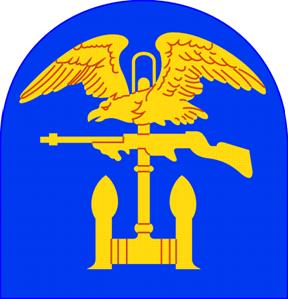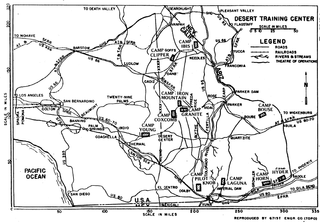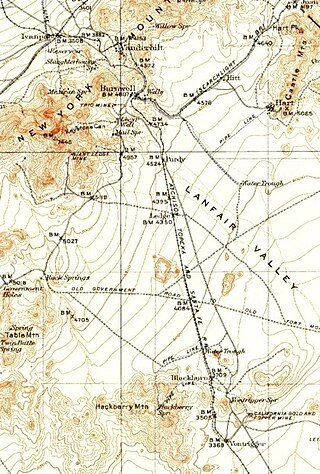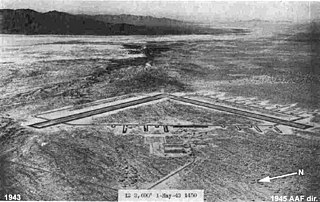
Quartermaster is a military term, the meaning of which depends on the country and service. In land armies, a quartermaster is generally a relatively senior soldier who supervises stores or barracks and distributes supplies and provisions. In many navies, a quartermaster is an officer with particular responsibility for steering and signals. The seaman is a non-commissioned officer rank; in some others, it is not a rank but a role related to navigation.
Goffs, an unincorporated community in San Bernardino County, California, is a nearly empty one-time railroad town at the route's high point in the Mojave Desert. Goffs was a stop on famous U.S. Route 66 until 1931 when a more direct road opened between Needles and Essex. Goffs was also home to workers of the nearby Santa Fe Railroad, with Homer east, Fenner south, and Blackburn and Purdy north. Goffs is also known as the "Desert Tortoise Capital of the World."

Essex is a small unincorporated community in San Bernardino County, California. Essex lies on Old National Trails Highway – part of the old Route 66 – just south of Interstate 40 in the Mojave Desert.

The General George S. Patton Memorial Museum, in Chiriaco Summit, California, is a museum erected in tribute to General George S. Patton on the site of the entrance of Camp Young, part of the Desert Training Center of World War II.

Norton Air Force Base (1942–1994) was a United States Air Force facility 2 miles (3.2 km) east of downtown San Bernardino in San Bernardino County, California.

Marine Corps Logistics Base Barstow is a United States Marine Corps supply and maintenance installation located in the Mojave Desert east of Barstow, in San Bernardino County, Southern California.
This is the order of battle of Allied and Japanese forces during the Admiralty Islands campaign of 1944.

The Engineer Special Brigades were brigade-sized amphibious forces of the United States Army developed during World War II and active from 1942 to 1955. Initially designated engineer amphibian brigades, they were redesignated engineer special brigades in 1943. The 1st, 5th, and 6th Engineer Special Brigades were assigned to the European Theater of Operations. The 1st Engineer Special Brigade participated in the landings in Sicily and Italy before joining the 5th and 6th Engineer Special Brigades for the invasion of Normandy.

The Desert Training Center (DTC), also known as California–Arizona Maneuver Area (CAMA), was a World War II training facility established in the Mojave Desert and Sonoran Desert, largely in Southern California and Western Arizona in 1942.

The Goffs Schoolhouse is a historic school building located at 37198 Lanfair Road in Goffs, California. Opened in 1914, the one-room schoolhouse was the first in Goffs used solely as a school; prior to its construction, the school district had used a rented building. Architect Anthony Beimer designed the Mission Revival building. The district served students in a 1,000-square-mile (2,600 km2) region surrounding Goffs; its students were the children of the area's miners and railroad workers. Many of the students came from Mexican immigrant families, and bilingual students often served as teacher's assistants to translate for the teacher. Goffs residents also used the school building as a community center, and it housed a branch of the San Bernardino County Library. The school closed in 1937, when the Goffs School District merged with the Needles district. During World War II, the school building served as a canteen for the Desert Training Center, the largest Army training facility in the United States. The Mojave Desert Heritage and Cultural Association now uses the building as a museum and cultural center.
Barnwell, originally a rail camp named Summit, then Manvel, was a former railhead serving local mining camps, now a ghost town, in San Bernardino County, California. It lies at an elevation 4806 feet in the New York Mountains.

California Eastern Railway, is a defunct 45-mile (72 km) short-line railroad that operated from 1902 - 1911. The railroad ran from Goffs, California, to Ivanpah. It was first a private line operated by a mining company, that was acquired by the Atchison, Topeka and Santa Fe Railway.
Mira Loma Air Force Station is a closed facility of the United States Air Force. It served as a depot for ICBM missile programs operated at Norton Air Force Base and Vandenberg Air Force Base, California. It also supported civil defense radiological equipment testing and maintenance.
Brent Prescott's Camp Ono existed from 1942 to 1947 in Southern California on 300 acres of land. The camp was four miles northwest of the City of San Bernardino, California.

The Temporary Detention Camp for Japanese Americans / Pomona Assembly Center is one of the places Japanese Americans were held during World War II. The Pomona Assembly Center was designated a California Historic Landmark on May 13, 1980. The Pomona Assembly Center is located in what is now called the Fairplex in Pomona, California in Los Angeles County. The Pomona Assembly Center was called Los Angeles County Fairgrounds in 1942.

The Camp Coxcomb was a sub camp of the US Army Desert Training Center in Riverside County, California. The main headquarters for the Desert Training Center was Camp Young where General Patton's 3rd Armored Division was stationed. Camp Coxcomb was designated a California Historic Landmark (No.985). The site of the Camp Granite is 45 miles East of Indio, California off Interstate 10 and California State Route 177 near the Coxcomb Mountains. The train stop at Freda railroad siding delivered Troops and equipment. The camp closed in early in 1944 after about two years of operations.

The Camp Clipper and Camp Essex were sub camps of the US Army Desert Training Center in Riverside County, California. The main headquarters for the Desert Training Center was Camp Young. This is where General Patton's 3rd Armored Division was stationed. Camp Clipper was designated a California Historic Landmark (No.985.5). The site of Camp Clipper is at the Fenner Rest Area in Fenner, California, on Interstate 40, 32 miles (51 km) west of Needles in San Bernardino County, California, near Clipper Mountains. Currently at the south end of the Mojave National Preserve. Camp Clipper was just to the east of Camp Essex. Clipper was a temporary camp for incoming and out going troops. Camp Essex was named after a small town near the camp, Essex, San Bernardino County, California. Near Camp Clipper was the 4,500 foot Camp Essex Army Airfield.

The Camp Desert Center was a sub camp of the US Army, Desert Training Center in Riverside County, California. The main headquarters for the Desert Training Center was Camp Young, where General Patton's 3rd Armored Division was stationed. Camp Desert Center was at Desert Center, California, in Riverside County, California in the Colorado Desert.

California during World War II was a major contributor to the World War II effort. California's long Pacific Ocean coastline provided the support needed for the Pacific War. California also supported the war in Europe. After the Japanese attack on Pearl Harbor on December 7, 1941, most of California's manufacturing was shifted to the war effort. California became a major ship builder and aircraft manufacturer. Existing military installations were enlarged and many new ones were built. California trained many of the troops before their oversea deployment. Over 800,000 Californians served in the United States Armed Forces. California agriculture, ranches and farms were used to feed the troops around the world. California's long coastline also put the state in fear, as an attack on California seemed likely. California was used for the temporary and permanent internment camps for Japanese Americans. The population grew significantly, largely due to servicemen who were stationed at the new military bases/training facilities and the mass influx of workers from around the U.S. in the growing defense industries. With all the new economy activity, California was lifted out of the Great Depression. Over 500,000 people moved to California from other states to work in the growing economy. California expanded its oil and mineral production to keep up with the war demand.
The Italian Service Units or ISUs were military units composed of Italian prisoners of war (POWs) that served with the Allies during World War II against Nazi Germany and the Empire of Japan from May 1944 to October 1945. The armed forces of the United States captured many Italian soldiers during the North African campaign Operation Torch, which started in November 1942 and sent 51,000 of them to the United States. After the signing of the armistice by the Badoglio government in Italy on September 8, 1943, and with Pietro Badoglio and the Kingdom of the South officially declaring war on Nazi Germany on October 13, 1943, the Americans began to see the POWs as potential allies. The capture of Rome by the Allies on June 4, 1944, motivated many POWs to change sides. About 90% joined Italian Service Units, which operated in the United States and overseas.




















